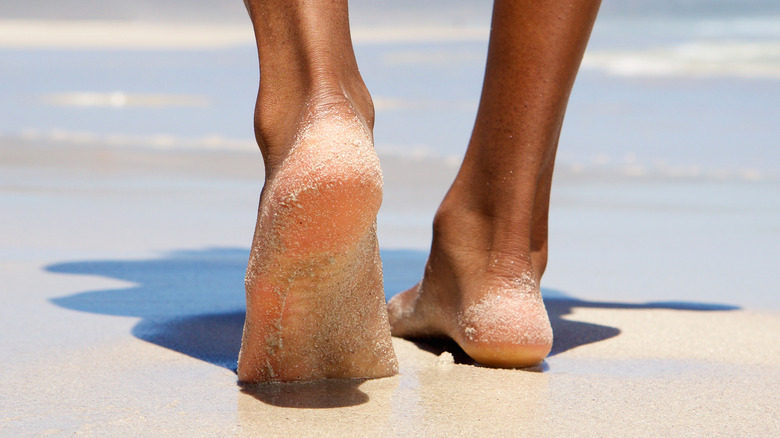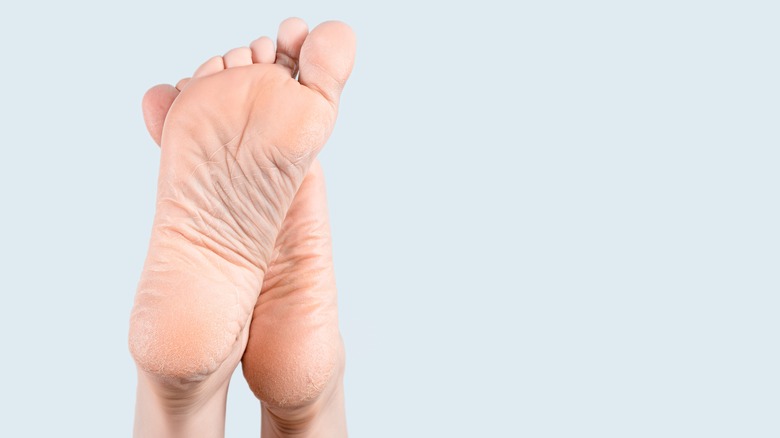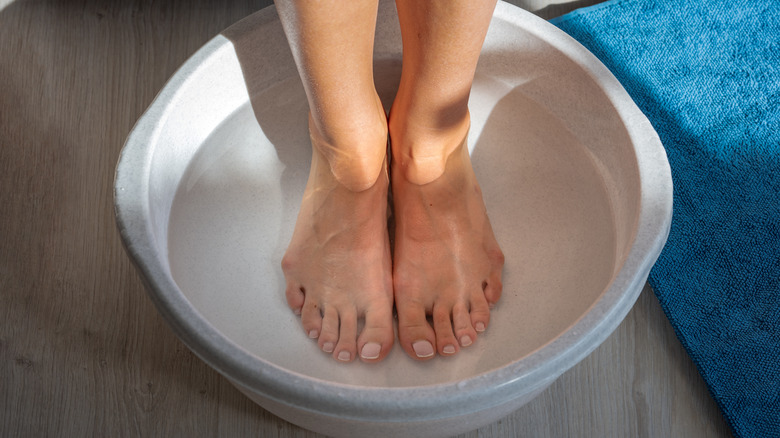Could Your Cracked Heels Be More Than Just Dry Skin?
Struggling to stay moisturized? Dry skin can be caused by a number of factors, from dry weather to hard water. Using harsh soaps, detergents, and shampoos that are formulated to wash away oil can also cause your skin to be dry, dermatopathologist Gretchen Frieling tells Everyday Health. Per the American Academy of Dermatology Association, people who are at higher risk of having dry skin include those above the age of 40, those with darker or paler skin tones, those who often come into contact with water or chemicals, those living in cold climates, and those who smoke. Depending on your risk factors and dry skin triggers, you may experience a thirsty complexion from your head to your toes.
It's not hard to tell when your skin is dehydrated. A prime example of dry skin is cracked heels, where the skin on the rim of your heels thickens and cracks begin to show. Though highly common among those living in a cold environment or who often walk around barefoot, cracked heels are a hard pill to swallow and might take time to get rid of. If left untreated, heel fissures can become painful and lead to more severe issues like skin infections (via Feet First Clinic). While dryness is a common cause of cracked heels, it's not the only one. Turns out, there may be a host of different reasons why your heels are cracked. Here's everything you need to know about cracked heels, from potential causes to home remedies.
Cracked heels can be tied to bigger health issues
Often, cracked heels can be tied to specific medical disorders. Eczema, diabetes, obesity, hypothyroidism, juvenile plantar dermatosis, flat feet, heel spurs, and Sjögren's syndrome are a few conditions that can lead to cracked heels, according to WebMD. Wearing open-heeled sandals and flip-flops without heel support or standing on your feet for a long time can also increase the risk of cracks forming.
While less common in the U.S., cracked heels can be a result of vitamin deficiency. In particular, this condition is commonly spotted among people who suffer from malnourishment and deficiencies of vitamins C, B-3, and E (via Central Texas Foot Specialist). Essential to skin health, vitamin C plays a big part in retaining moisture and producing collagen. Vitamin B-3, or niacin, is also very important for both your metabolism and your skin. Lack of vitamin B-3 can lead to pellagra, a condition that causes the skin to form dry, scaly patches — including on your heels. Meanwhile, a shortage of vitamin E, an antioxidant that helps shelter your cells from damage, can result in dull, cracked skin, and premature aging.
So, what can you do to care for cracked heels? If your condition doesn't need medical attention, there are a number of methods you can try to cure cracked skin at home.
How to treat cracked heels
When your skin is unable to keep up moisture levels and begins to crack, Mayo Clinic suggests frequently applying moisturizer or soothing balm to keep it hydrated and supple. Soaking your feet in warm water and gently sloughing off dead skin from your heels is also a good way to prevent your hard-working or perpetually dry heels from cracking. To soften rough skin patches, you can check out hydrating foot creams that are rich in humectants like glycerin or hyaluronic acid, exfoliating ingredients like glycolic and salicylic acids, and moisture-lockers like dimethicone and shea butter (via Prevention). Petroleum jelly is also able to moisturize skin and treat cracks. Before going to bed, apply a thick layer of foot cream to your heels, and then put on some socks to keep the moisture in.
If red patches develop in the cracked skin or it feels itchy, apply an OTC hydrocortisone cream to help decrease irritation, per Healthline. If the cracks get so deep and dry they start to feel raw inside, get yourself a liquid bandage to hold the skin together and help it heal properly. And to prevent new or worsening areas of dry skin, refrain from scratching or rubbing the area and avoid baring your feet to extremely cold or sunny weather. But if your cracked heels are bleeding, inflamed, excruciating, or infected with open sores, the time for DIY solutions has passed, and you need to visit a doctor for timely treatment.


